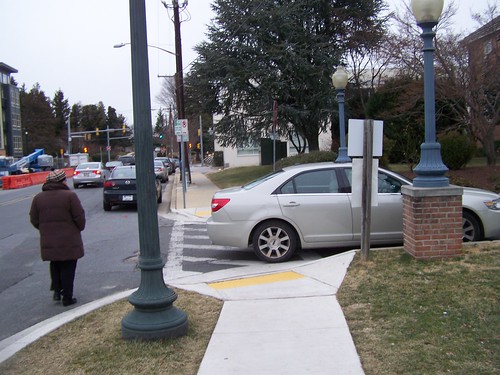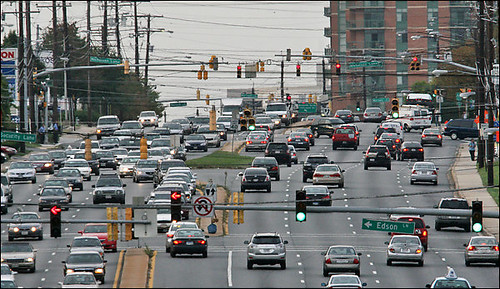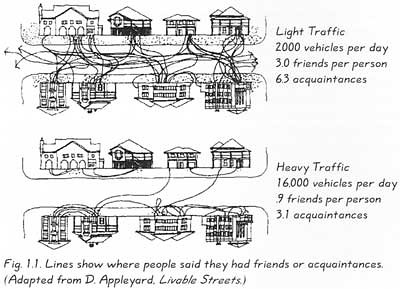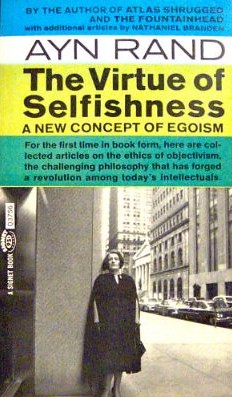Real entitlement of Crownsville Maryland
 The car parked in a pedestrian crosswalk pictured in the photo at left is actually parked in Silver Spring, Maryland. But this area of Silver Spring has a goodly amount of pedestrian traffic. The behavior of parking in the crosswalk depicts the kind of "me first/car first" attitude that is discussed below.
The car parked in a pedestrian crosswalk pictured in the photo at left is actually parked in Silver Spring, Maryland. But this area of Silver Spring has a goodly amount of pedestrian traffic. The behavior of parking in the crosswalk depicts the kind of "me first/car first" attitude that is discussed below.I'm sure most readers are familiar with the Real Housewives tv franchise on Bravo. While I think that the managers of the Bravo TV network need to be brought up on charges because of how their programs degrade society, the shows are great for demonstrating both a sense of entitlement and over-the-top behavior.
 Right: Rockville Pike in Montgomery County, Washington Post photo by Bill O'Leary.
Right: Rockville Pike in Montgomery County, Washington Post photo by Bill O'Leary.I think that Laura Gore of Crownsville, Maryland demonstrates an equivalent level of entitlement in her letter to the editor, "Commuting headaches in the District," in yesterday's Post. Ms. Gore commutes to DC to work and she believes that how she wants to use our roads ought to dictate how the city treats her when she does so.
It's fair to say that most suburbanites fail to understand that mobility in the center city, involving as it does more pedestrians, more bicyclists, and more transit, is fundamentally different than mobility in suburbs, which more typically is centered around facilitating the automobile.
The letter:
Thank you, District of Columbia, for all the new bike lanes! My commute down L Street NW is now 15 minutes longer, and many cyclists still refuse to obey traffic laws such as stop signs and red lights.
And thanks to how the District manages the traffic lights, my car each night never goes farther than about 200 feet to the next red light — crawling through the District at a snail’s pace. Each light lasts about a minute, so that adds another 20 minutes to my commute, because I hit about 20 of them.
Also, thank you so much for the $125 ticket I received for doing 36 mph in a 25 mph zone. I’m not kidding — $125 for that. It’s small consolation that the District has since dropped the fine to $100.
With all the millions the District is raking in from red-light and speed cameras, could it please hire an expert who knows how to manage traffic efficiently? And while you are at it, can someone repave the roads?
1. The bike lane on L Street NW is only a few blocks long. I can't believe it would lead to a 15 minute increase in commute time. Plus given that Crownsville is east of DC, not north, I don't understand why should would even be using L Street unless it is to go back to New York Avenue during evening rush hour.
2. Traffic signals can always be better coordinated, but DC doesn't fully coordinate traffic signals to facilitate traffic throughput because the city attempts to balance sustainable mobility--walking, biking, transit--with free flow of traffic. At the same time, the reality is that the streets have only so much capacity (a lane on a 300 foot long block can fit slightly more than 20 cars).
3. Speed limits in DC are set based on the fact that the city is for the most part, residential (see the discussion on desired operating speed limits in the Smart Transportation Guidebook) and walking oriented. She was travelling almost 50% higher than the posted speed limit, and she sees nothing wrong?
Image from Oswego County Today.
Probably she is likely to see nothing wrong with cars "blocking the box" for traffic on perpindicular streets (this happens a lot on Riggs Road and New Hampshire Avenue--both of which are relied upon by Marylanders commuting into DC), running red lights (a Toyota van Maryland license plate 7AF3549 almost hit me running a red light at Blair Road and Riggs Road many seconds after the light changed), pulling into crosswalks thereby impeding pedestrian movement, and parking in crosswalks.
4. Who says traffic isn't being managed efficiently? Unless the definition of efficient is to prioritize the facilitation of nonresident commuter traffic in and out of the city at the expense of quality of life of the residents (see Donald Appleyard's Livable Streets and David Engwicht's Reclaiming our cities and towns: better living through less traffic).

5. I do agree that more money needs to be spent on road pavement quality, including bike lanes (e.g., the 15th Street Cycletrack mostly has pavement that is seriously substandard--1s and 2s on a 5-point scale, under 5 on a 10-point scale). Part of the reason that DC has frequent budget surpluses is because of underspending on necessary priorities, which includes the ongoing plan for road repaving/rehabilitation.

Crownsville is about 35 miles from DC, and the letter is an illustration of the point that I make that the farther one lives from the center city in a metropolitan area, the less likely they are to care much about or feel associated to the center city.
Labels: car culture and automobility, urban design/placemaking




5 Comments:
"Part of the reason that DC has frequent budget surpluses is because of underspending on necessary priorities, which includes the ongoing plan for road repaving/rehabilitation."
How do we know this? How do we know anything about the sources and uses of funds to run the DC government? Is there a single place on the DC Website where one could find that information? If not, why not?
There is such a lack--bordering on the criminal--of transparency in DC government, especially considering the huge amounts of public resources (tax dollars, property, employees, etc.) involved.
Apparently, the electorate doesn't care.
-EE
http://budget.dc.gov/
She isn't stuck in traffic. She IS traffic.
Dear rg-
Many thanks for the URL to the DC budgeting labyrinth--this should keep me busy for a few days! Will report back with my observations.
-EE
Thanks so much for the site, I found a lot of useful information for us.
Post a Comment
<< Home